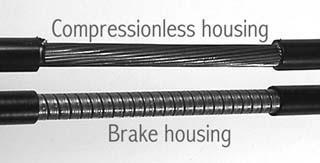
With the outer plastic coating removed, the difference between longitudinally-stranded 'compresionless' shift housing and wound brake housing is obvious. These two varieties are purpose-specific and not interchangeable.
|
|
|
With the outer plastic coating removed, the difference between longitudinally-stranded 'compresionless' shift housing and wound brake housing is obvious. These two varieties are purpose-specific and not interchangeable. |
Almost all gear and brake cables on bicycles are of the multi-strand type in which many strands of wire are twisted together. 'Braided' cable, which has the wire strands woven together as in a rope, is now rare, and for the purposes of repair can be treated the same as twisted cable.
There are two types of housing: 'compressionless' housing, intended for gear cables, and wound housing, for brake cables.
Compresionless housing uses many inner support wires running longitudinally within an inner plastic liner. Compressionless housing is intended for shifting systems only, not braking. The longitudinal strands in this housing act to maintain constant housing length when the housing is curved and so prevent 'ghost' shifts when the handlebars are turned.
Despite its name, compresionless housing is actually weaker in compression than wound housing. Brake housing must resist compression when the brake cable is pulled, so compressionless housing must not be used for brake systems.
Brake housing is made of a wire wound around a plastic liner. This design resists the compression that occurs in reaction to the brake cable being pulled by the brake lever.
Housing ferrules are steel or plastic caps that fit over the end of teh housing and have a hole for the cable to pass. Ferrules should be used with all housings whenever possible. Cable ends should be capped with soft aluminium cable end caps to prevent them fraying.
Cable cutters are designed to cut multi-strand wires such as gear and brake cable, brake housing, and compressionless gear housing. The jaws of the cable cutter surround and then sheer the material. Using plain diagonal cutters can simply flatten and smash cables. As with all cutting tools, it is recommended to wear eye protection.
|
|
|
Grab and hold the cable or housing close to the jaws. Use care not to cut your fingers. Hold cable or housing perpendicular to jaws and squeeze levers quickly for a clean cut. |
|
|
After cutting compressionless gear housing, inspect the end to see if it has been flattened a bit. Use the crimper section of the CN-10 or CN-4 to open up the housing and inner liner before installing a ferrule and cable. You can also use the crimper section cutter to crimp on a cable end cap, as seen left. |
Brake and gear housing allows the cable wire to be routed around bends and connects the levers to the frame stops. The less the drag on the cables, the better for the shifting and braking. Too short of housing will cause it to kink and bind, making even more friction. As a rule of thumb, try to size the housing so it is as short as possible but it still enters the stops and barrel adjusters in a straight approach. For the rear derailleur housing, note especially how the housing enters the barrel adjuster.
|
|
|
In the left image above, the housing bends immediately upon leaving the barrel adjuster. This can actually bend the housing end cap. The image to the right shows how longer housing in this case allows the housing to enter straight. |
|
|
|
The left image above is a typical new bike housing length. The housing bends and kinks as it enters the barrel adjuster. The image to the right shows longer housing allowing a straight entry into the barrel adjuster. |
|
|
The image left shows brake and shift housing which is much too long. The housing could be shortened and still have a smooth, straight approach to the levers and housing stops. |
The routing of housing may affect the length. Typically the front derailleur shift housing is run on the left side of the frame, while the rear derailleur shift housing is run on the right. This may at time cause unnecessary bending in the housing. In some cases, it is possible to "cross over" the housing, running the front shifter to the right side stop, and the rear shifter to the left side stop. It will then be necessary to again cross the cable. Consider this option, but if the cable ends up rubbing the frame, it is not a good idea. There may be some light rubbing between cables, but this would result in less friction than poorly routed housing.
|
|
|
|
Left: the shift lever housing is too long. Housing passes center line of bike, then must bend back to housing stops. Right: Shift housing is crossed over at headtube, and crossed again on downtube. Arc of housing is much smoother than black housing in example of too long housing. |
|
|
|
|
Brake housing may be cut with cable cutters or diagonal pliers. Because of the design of the housing wire, it is not always possible to get a flat, clean cut. It is best to finish any burr with a file. Lightly grinding the end will also improve the housing and reduce friction. NOTE: Compressionless housing does not require finishing. |
As a cable cutter wears, it may require readjustment for best cutting results. Grab the handles and wiggle them against the axis of the thread. If there is play between handles, turn locknut counterclockwise to loosen nut, turn bolt head clockwise slightly to tighten adjustment, and retighten locknut. Repeat adjustments as needed until tool cuts cable cleanly. If handles bind, turn locknut counterclockwise to loosen nut, turn bolt head counterclockwise slightly to tighten adjustment, then retighten locking nut. Repeat adjustments as needed until tool cuts cable cleanly.
Index to Cyclingnews tech features